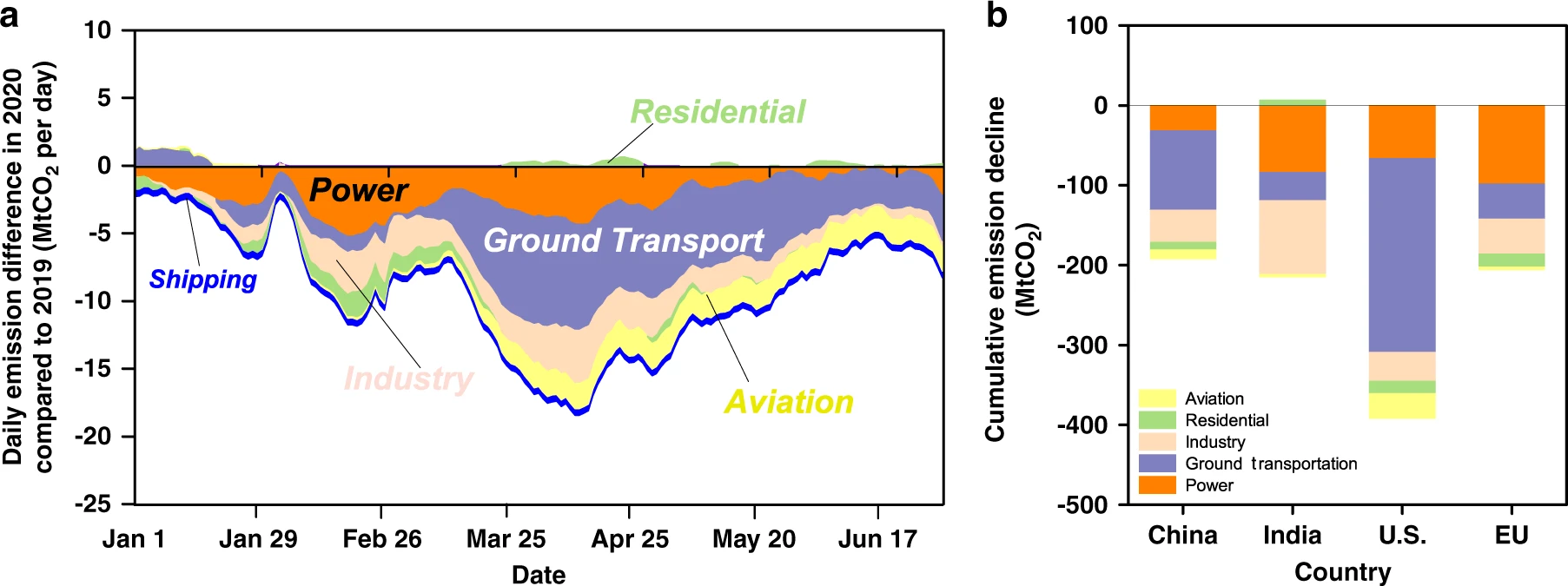
While the ongoing Corona pandemic continues to threaten millions of lives around the world, the first half of 2020 saw an unprecedented decline in CO2 emissions – larger than during the financial crisis of 2008, the oil crisis of the 1979, or even World War II. An international team of researchers has found that in the first six months of this year, 8.8 percent less carbon dioxide was emitted than in the same period in 2019 – a total decrease of 1551 million tonnes. The groundbreaking study not only offers a much more precise look at COVID-19’s impact on global energy consumption than previous analyses. It also suggests what fundamental steps could be taken to stabilize the global climate in the aftermath of the pandemic.
“What makes our study unique is the analysis of meticulously collected near-real-time data” explains lead author Zhu Liu from the Department of Earth System Science at Tsinghua University in Beijing. “By looking at the daily figures compiled by the Carbon Monitor research initiative we were able to get a much faster and more accurate overview, including timelines that show how emissions decreases have corresponded to lockdown measures in each country. In April, at the height of the first wave of Corona infections, when most major countries shut down their public life and parts of their economy, emissions even declined by 16.9 %. Overall, the various outbreaks resulted in emission drops that we normally see only on a short-term basis on holidays such as Christmas or the Chinese Spring Festival.”
The study, published in the latest issue of Nature Communications, shows which parts of the global economy were most impacted. “The greatest reduction of emissions was observed in the ground transportation sector,” explains Daniel Kammen, professor and Chair of the Energy and Resources Group and also professor in the Goldman School of Public Policy, University of California, Berkeley. “Largely because of working from home restrictions, transport CO2 emissions decreased by 40 % worldwide. In contrast, the power and industry sectors contributed less to the decline, with -22 % and -17 %, respectively, as did the aviation and shipping sectors. Surprisingly, even the residential sector saw a small emissions drop of 3 %: largely because of an abnormally warm winter in the northern hemisphere, heating energy consumption decreased with most people staying at home all day during lockdown periods.”
To paint this comprehensive and multidimensional picture, the researchers based their estimates on a wide array of data: precise, hourly datasets of electricity power production in 31 countries, daily vehicle traffic in more than 400 cities worldwide, daily global passenger flights, monthly production data for industry in 62 countries as well as fuel consumption data for building emissions in more than 200 countries.
The researchers also found strong rebound effects. With the exception of a continuing decrease of emissions stemming from the transportation sector, by July 2020, as soon as lockdown measures were lifted, most economies resumed their usual levels of emitting CO2. But even if they remained at their historically low levels, this would have a rather minuscule effect on the long-term CO2 concentration in the atmosphere.
Thus, the authors stress that the only valid strategy to stabilize the climate is a complete overhaul of the industry and commerce sector. “While the CO2 drop is unprecedented, decreases of human activities cannot be the answer,” says Co-Author Hans Joachim Schellnhuber, founding director of the Potsdam Institute for Climate Impact Research. “Instead we need structural and transformational changes in our energy production and consumption systems. Individual behavior is certainly important, but what we really need to focus on is reducing the carbon intensity of our global economy.”

